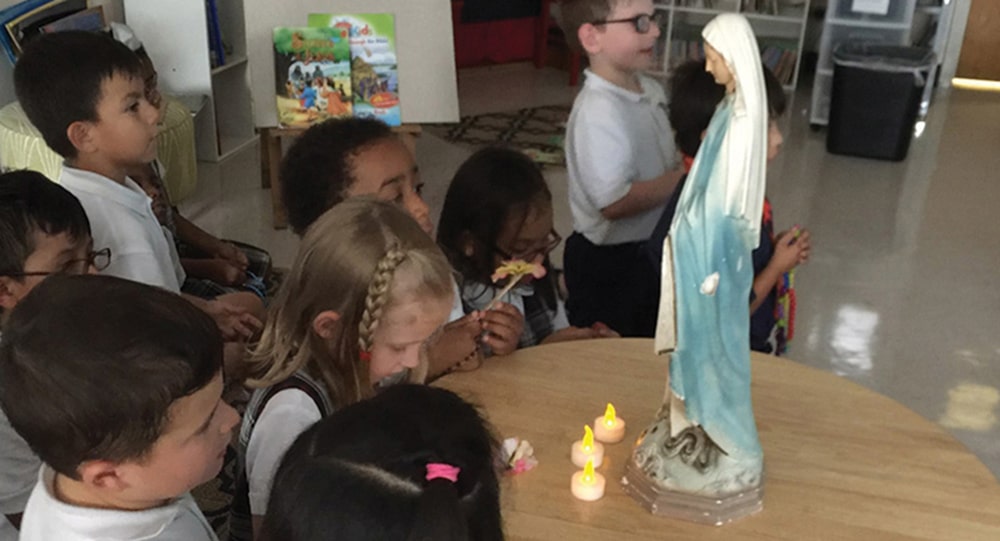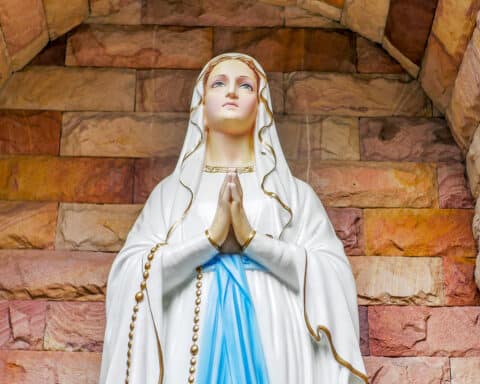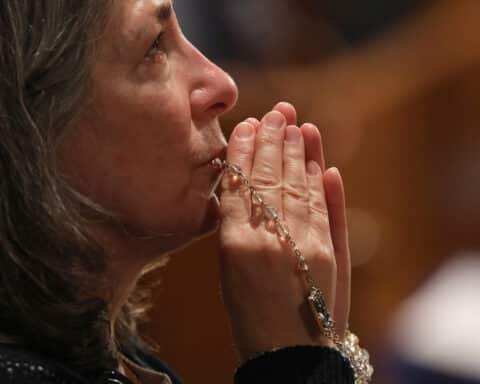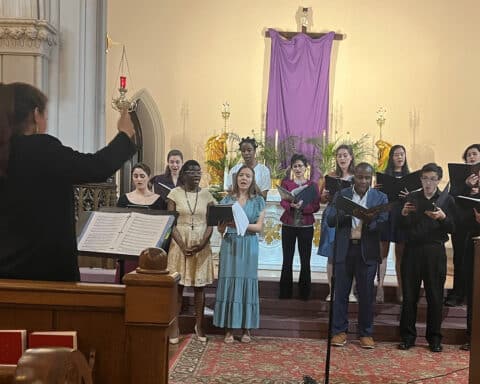After learning that Blythe Kaufman, founder of Children’s Rosary, was filming at the nearby EWTN headquarters in Birmingham, Alabama, Nathan Wright, principal of the Diocese of Birmingham’s St. Francis Xavier School, invited her to the campus to organize a school Rosary with St. Francis students.
Wright was interested in promoting the Rosary, and said he “bought in to her particular charism about promoting the Rosary to youth, which is less about teaching and more about praying.”
Wright was impressed how the children took to the Rosary, adopting it for the 2017-18 school year and again for 2018-19. The 200 children grades K-8 pray the Rosary on Fridays over the intercom, with the students leading, which is “an important, distinctive feature.”
Components of the St. Francis Children’s Rosary include: 1) the children leading each other, 2) honoring a statue of the Blessed Mother, and laying a flower at her feet marking the fruit of each mystery, and 3) having a component of kneeling, which is “a promotion of the sacred.”
“This was our way of inviting the Blessed Mother into the life of our school in a significant way,” Wright said. “And, she has responded to our invitation by improving our school culture.”
He believes the school has become a more peaceful place, with less conflict between students and teachers, and has “a greater sense of order and calm.” He added, “The Blessed Mother was Jesus’ first teacher, and we think she is moving our school toward an education she’d like to have for her own son.”
Worldwide movement
Children’s Rosary is a lay prayer movement for children ages 4-14. It is active in 30 countries and has hundreds of registered groups. The movement began in 2011, when Father Arthur Murphy (1929-2013) of the Archdiocese of Hartford, Connecticut, warned parishioners that their parish, St. Thomas the Apostle in West Hartford, was running short of funds and risked being merged with another parish. He pled for donations over a period of weeks, but none came.
Kaufman recalled, “The prayers of children are dear to Our Lord, so I asked him if we could gather and pray for the parish’s needs.”
On Sunday, April 10, 2011, the first Children’s Rosary group met, and the subsequent collection was the largest the parish had for the year, except for Christmas and Easter. And, although the archdiocese would see many parish closings and mergers in the following years, St. Thomas the Apostle was not among them.
Kaufman and her fellow parents were impressed with the fruits of Children’s Rosary, and continued. In 2012, a group in Washington State started the second Children’s Rosary group. The program has steadily grown to include many parishes, schools and orphanages worldwide.
The Bac Hoa orphanage in Bien Hoa, Vietnam, for example, has a Children’s Rosary daily. Nativity of Jesus Parish in Magadan, Russia, meets weekly. There are also groups in Haiti, Kenya, Uganda, Mexico, Argentina, England, Australia, Belgium, the Philippines and Uruguay. In an effort to establish Children’s Rosary groups in 30 schools in Uganda, Kaufman recently sent two barrels containing 13,152 rosaries, 1,050 Children’s Rosary books and two statues of Mary.
Recordings of Children’s Rosary have been picked up for daily broadcast on EWTN Radio Classics; EWTN television broadcasts it weekly.
Kaufman believes it has produced many fruits. “One of the beautiful things I have seen come from Children’s Rosary is witnessing the Faith passed on to our children. … Establishing a prayer life as a child is so important. Many challenges will come, but if a child has a friendship with Our Lord and his mother, he or she will be able to weather these challenges.”
Prayer, Catholic culture
Although specifics of Children’s Rosary can vary, the basic session involves gathering before a statue of the Blessed Mother, ideally in a church, kneeling and having the children lead the Rosary. The primary goal is to encourage children to pray, and participants are welcome to offer petitions for family and friends.
Each decade has a fruit (e.g. purity), and a flower is laid at the foot of the statue with each fruit. The Rosary ends with a song and can be followed by social time. Parents are welcome to stay and participate. Kaufman has authored a Children’s Rosary booklet to help guide groups through the Rosary.
Cheryl Batter brought Children’s Rosary to her parish, Sacred Heart Church in East Berlin, Connecticut, six years ago at the invitation of Kaufman. The group meets monthly and draws 10 children.
Batter said she has seen youth “blossom spiritually” through their participation, and more eagerly participate in the activities of their parish.
She has also seen benefits derived by the parent participants who attend their program and stay for the prayers. She pointed to one father, who had long sought a job with the fire department. Batter said, “His prayer life deepened, and he was motivated to pray about his situation.”
He landed a fireman job in July, which the group attributes to Mary’s intercession. Batter continued, “His faith has been tremendously strengthened, and he says that Children’s Rosary is the best thing he does all month.”
“Families used to pray the Rosary more at home. With Catholic culture on the decline, that’s not the case anymore,” Wright noted. “Children’s Rosary is a way we can help bring back that Catholic culture.”
“Children’s Rosary is a wonderful organization, which believes everyone is called to pray the Rosary, especially children,” Batter added. “Recalling Our Lady of Fátima, who asked the three children to pray the Rosary, participants in Children’s Rosary are finding their faith strengthened. I hope this will help usher in a period of greater peace in our world.”





